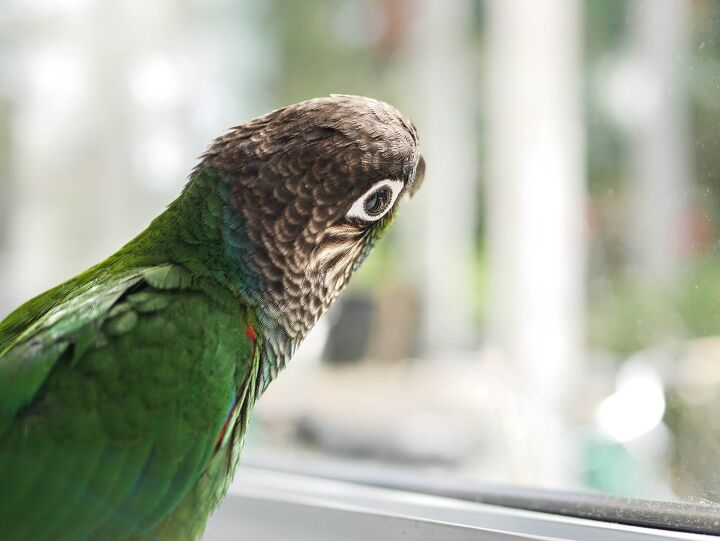Pearly Conure


About Pearly Conure
When it comes to fun and games, there are no bigger clowns in the parrot world than the Pyrrhura family members. The Pearly Conure, also known as Pearly Parakeet, is a real goof and one of the gentler members of this species. When compared to the much popular Maroon Bellied Conure or Black Capped Conure, these birds have much calmer personalities and are rare on the pet market, making them very sought-after. But thanks to their endlessly fun behavior, every member of this family has great potential and they often become stars of social media platforms such as Instagram, where they are loved for their antics, tricks, and cute looks. Let’s get to know these adorable clowns!
Owing to their goofy nature, love for various tricks, and friendliness, Pearly Conure is a treasured pet around the world.
Native Region/Natural Habitat
Found only in a relatively small region in Brazil, they span parts of provinces of Para and Maranhao. They are a vulnerable breed, with only 10,000 birds remaining in the wild. Pearly Conure thrives mostly in the regional tropical rainforests, and are also spotted on its edges and sporadic clearings. Brazil’s irresponsible policy towards wildlife has contributed to the diminishing of this breed. Heavy logging, destruction of habitat and flooding are the main causes. In the eastern edges of its habitat, one of its subspecies is nearing extinction because of this.
The famous Pyrrhura conures are undeniably striking, but often quite similar among themselves. Sometimes only a detail will help differentiate them, like a brighter hue of feathers. But what they all share are physical traits like their stout body and a peculiarly cute look that cannot be resisted. The adult Pearly Conure reaches an average length of 9 inches (24 centimeters) and can weigh around an ounce (40 grams). The first thing that you’ll notice, after the stunning appearance, is their energy. These little goofs are constantly hopping about from place to place, and they are really lively. This requires a very spacious cage and plenty of exercise around your home.
Conures are known to be noticeably quieter than some other, larger exotic parrots. Their natural calls are soft, with brief moments of shrill and loud calls in the morning and late noon. While the popular Sun and Jenday Conure can be considered noisy, the Pearly Conure is much quieter. They will often chatter softly, muttering something to themselves, but can also be trained to repeat some basic syllables and words, with a bit of patient training of course.
All the little details and intricate patterns that are hiding in the plumage of the Pearly Conure makes them exceptionally charming. The body is mostly dark, forest green. The nape, neck, and head are black, with prominent tones of light gray. These two colors combined, give a peculiar pattern that gives them their name. Red lines on the shoulders complete this look and give them an interesting detail that stands out and provides contrast. One thing is for sure, seeing a Pearly Conure up close is definitely going to leave a lasting impression.
Pearly Conure is one of the quietest breeds in the species- they make a good choice for spacious apartments.
In their natural habitat, these conures thrive with the help of a varied diet. Usually, it consists of the basics – fruits, insects, seeds and crops. For a good beginners diet, choose a commercial seed mix for conures or parakeets. This is the best choice for your pet, as it has all the important nutrients that are found in seeds like maize, rye, oats, and millet. Bathing your pet parrot should be a big part of your weekly routine. It makes your pet happy, promotes a bond between the parrot and the owner, and maintains hygiene. This three-in-one aspect makes bathing a priority.
These are robust and hardy birds, even if their size and cute appearance say otherwise. As pets, they are documented to live for more than 20 years, which makes them a good choice as companion parrots. But their health needs to be maintained. Avoid confined spaces and prolonged stay in a cage. The cage itself needs to be of a minimal length of 6.5 feet (2 meters) and filled with perches, swings, ropes and sterilized parrot toys. These goodies will help satisfy the curious and playful nature of these parrots and give you a bit of time for yourself. A bird room is also a great option for the Pearly Conure.
Offer a cuttlebone to your parrot pet. It is a great source of calcium and other vitamins.
The Pearly Conure might be among the rarer breeds in their family, but it doesn’t diminish their popularity. Owing to their goofy nature, love for various tricks, and friendliness, they are a treasured pet around the world. In fact, there are a lot of these adorable birds that have also conquered the social media and became bona fide Instagram and YouTube stars because of their charm. Pearly Conure is also very affectionate and will love to cuddle and snuggle up, once the play is over.

A proud mama to seven dogs and ten cats, Angela spends her days writing for her fellow pet parents and pampering her furballs, all of whom are rescues. When she's not gushing over her adorable cats or playing with her dogs, she can be found curled up with a good fantasy book.
More by Angela Vuckovic
























